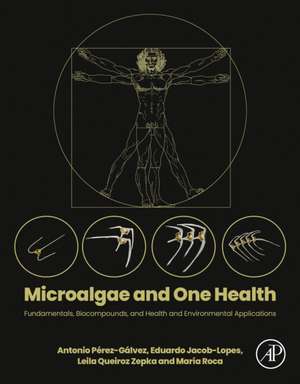Microalgae and One Health: Fundamentals, Biocompounds, and Health and Environmental Applications
Editat de Antonio Pérez-Gálvez, Eduardo Jacob Lopes, Leila Queiroz Zepka, María Rocaen Limba Engleză Paperback – iun 2025
Written by a globally diverse network of experts, this book is systematically structured to illustrate the applications of microalgae. The first section of the book covers the fundamentals of microalgae, from chemistry to industry applications. The next section further examines microalgae chemistry and identifies bioactive compounds. Subsequent sections examine the utility of microalgae in One Health, from human therapeutic potential to animal health and sustainability. The book concludes with a comprehensive market analysis, regulatory discussion, and safety considerations associated with microalgae products.
- Explores the interface between microalgae and the One Health approach
- Analyzes the contributions of microalgae-based products to human, animal, and environmental health
- Addresses and offers solutions to market, safety, and regulatory issues
Preț: 1199.16 lei
Preț vechi: 1565.35 lei
-23% Nou
Puncte Express: 1799
Preț estimativ în valută:
229.46€ • 240.18$ • 190.98£
229.46€ • 240.18$ • 190.98£
Carte nepublicată încă
Doresc să fiu notificat când acest titlu va fi disponibil:
Se trimite...
Preluare comenzi: 021 569.72.76
Specificații
ISBN-13: 9780443220807
ISBN-10: 0443220808
Pagini: 550
Dimensiuni: 216 x 276 mm
Editura: ELSEVIER SCIENCE
ISBN-10: 0443220808
Pagini: 550
Dimensiuni: 216 x 276 mm
Editura: ELSEVIER SCIENCE
Cuprins
Part I: Fundamentals
1. Microalgae in the context of One Health
2. Microalgae in food design and health nutrition
3. Microalgae in animal wellness
4. Microalgae-based technologies applied to environmental sustainability
5. Chemical composition of microalgae with potential for bioactive compounds
6. Metabolic plasticity of microalgae and its interfaces with environmental processes
7. Technologies for microalgae production
8. Algae industry and the farm-to-fork strategy
Part II: Biocompounds from Microalgae
9. Proteins and peptides
10. Carbohydrates and exopolysaccharides
11. Lipids and fatty acids
12. Minerals, vitamins, and trace elements
13. Chlorophylls and their derivatives
14. Carotenes and xanthophylls
15. Phycobiliproteins: phycocyanin, allophycocyanin, and phycoerythrin
16. Sterols
17. Phenolic compounds
18. Toxins
19. Recent advances in the discovery of novel microalgae-based molecules
Part III: Therapeutic Potential and Applications in Humans
20. Microalgae as an agent to improve blood quality and prevention of anemia
21. Evidence of use of microalgae on glycemic control and glucose metabolism
22. Anti-inflammatory molecules in microalgae
23. Antioxidant potential of microalgae
24. Microalgae with immunomodulatory activities
25. Microalgae for the prevention of cardiovascular diseases
26. Microalgae as a neuroprotective agent
27. Evidence of use of microalgae in cancer therapy
28. Microalgae on cataract and macular degeneration protection
29. Evidence of use of microalgae as antimicrobial agent
30. Microalgae potential on the treatment of allergic rhinitis
31. Microalgae as vaccine transporters
32. Microalgae in the production of monoclonal antibodies
33. Microalgal-based micro/nanocarriers in drug delivery
Part IV: Microalgae and Their Animal Health-Promoting Benefits
34. Applications of microalgae for disease control in aquaculture
35. Evidence of poultry health and microalgae
36. Microalgae and its impact on ruminant nutrition and health
37. Benefits of the use of microalgae on nutrition and health of monogastrics
38. Performance of microalgae-based feed on pet health
Part V: Environmental Sustainability and Applications
39. Microalgae in wastewater treatment
40. Microalgae in the removal of emerging pollutants
41. Microalgae in greenhouse gas control
42. Microalgae applications in soil improvement
43. Sustainability metrics and indicators in microalgae-based processes and products
Part VI: Market Analysis, Safety, and Regulatory Aspects
44. The bioeconomy of microalgae-based products
45. Market analysis of microalgae-based products
46. Safety issues on microalgae-based products
47. Regulatory key points on microalgae-based products
1. Microalgae in the context of One Health
2. Microalgae in food design and health nutrition
3. Microalgae in animal wellness
4. Microalgae-based technologies applied to environmental sustainability
5. Chemical composition of microalgae with potential for bioactive compounds
6. Metabolic plasticity of microalgae and its interfaces with environmental processes
7. Technologies for microalgae production
8. Algae industry and the farm-to-fork strategy
Part II: Biocompounds from Microalgae
9. Proteins and peptides
10. Carbohydrates and exopolysaccharides
11. Lipids and fatty acids
12. Minerals, vitamins, and trace elements
13. Chlorophylls and their derivatives
14. Carotenes and xanthophylls
15. Phycobiliproteins: phycocyanin, allophycocyanin, and phycoerythrin
16. Sterols
17. Phenolic compounds
18. Toxins
19. Recent advances in the discovery of novel microalgae-based molecules
Part III: Therapeutic Potential and Applications in Humans
20. Microalgae as an agent to improve blood quality and prevention of anemia
21. Evidence of use of microalgae on glycemic control and glucose metabolism
22. Anti-inflammatory molecules in microalgae
23. Antioxidant potential of microalgae
24. Microalgae with immunomodulatory activities
25. Microalgae for the prevention of cardiovascular diseases
26. Microalgae as a neuroprotective agent
27. Evidence of use of microalgae in cancer therapy
28. Microalgae on cataract and macular degeneration protection
29. Evidence of use of microalgae as antimicrobial agent
30. Microalgae potential on the treatment of allergic rhinitis
31. Microalgae as vaccine transporters
32. Microalgae in the production of monoclonal antibodies
33. Microalgal-based micro/nanocarriers in drug delivery
Part IV: Microalgae and Their Animal Health-Promoting Benefits
34. Applications of microalgae for disease control in aquaculture
35. Evidence of poultry health and microalgae
36. Microalgae and its impact on ruminant nutrition and health
37. Benefits of the use of microalgae on nutrition and health of monogastrics
38. Performance of microalgae-based feed on pet health
Part V: Environmental Sustainability and Applications
39. Microalgae in wastewater treatment
40. Microalgae in the removal of emerging pollutants
41. Microalgae in greenhouse gas control
42. Microalgae applications in soil improvement
43. Sustainability metrics and indicators in microalgae-based processes and products
Part VI: Market Analysis, Safety, and Regulatory Aspects
44. The bioeconomy of microalgae-based products
45. Market analysis of microalgae-based products
46. Safety issues on microalgae-based products
47. Regulatory key points on microalgae-based products
